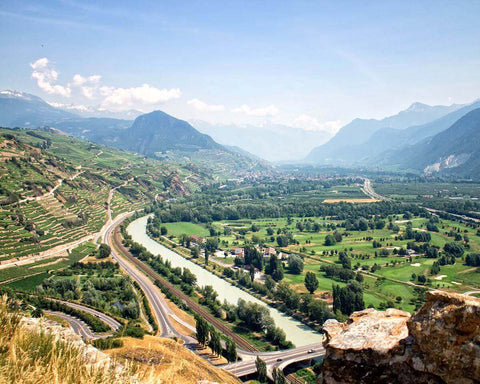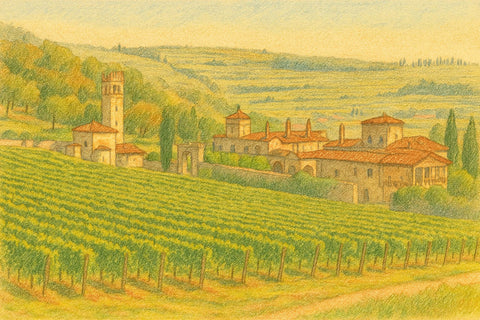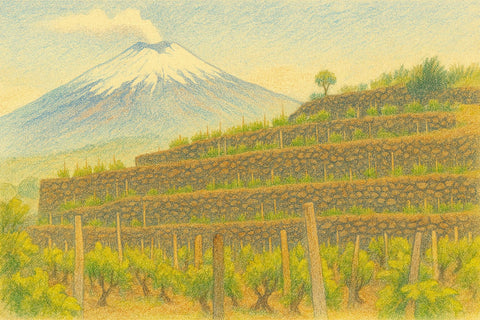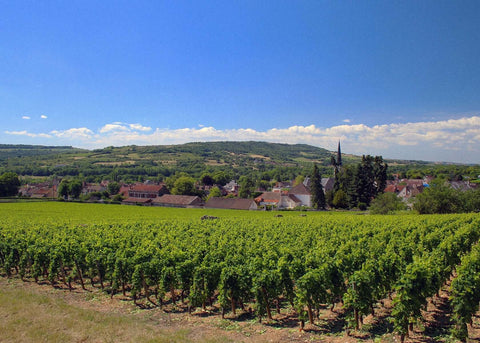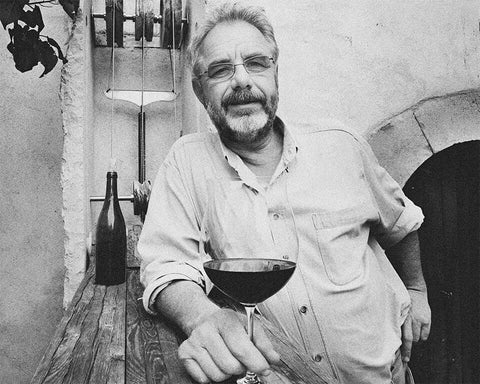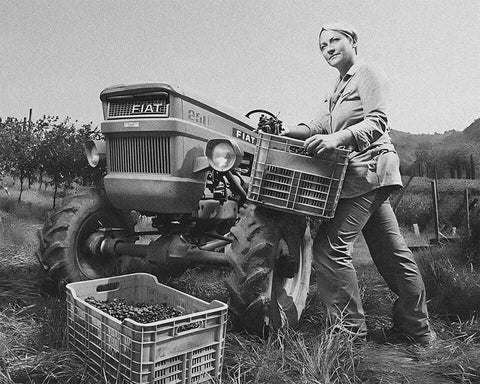Catalonia, situated in northeastern Spain along the Mediterranean coast, stands as one of Europe's most dynamic and innovative wine regions. Bordered by France to the north, Aragon to the west, and Valencia to the south, this autonomous community creates wines that range from world-renowned sparkling Cava to bold, age-worthy reds from Priorat's ancient vineyards. Catalonia's diverse terroir, spanning from coastal plains to rugged mountains, combined with its rich winemaking heritage and progressive spirit, produces wines celebrated for their quality, diversity, and distinctive Mediterranean character.
Over the centuries, Catalonia has evolved from an ancient viticultural region into one of Spain's most internationally recognized wine-producing area, pioneering modern winemaking techniques while honoring traditional practices. The region's commitment to both innovation and heritage, combined with its exceptional terroir diversity, produces wines that range from everyday drinking to some of Spain's most prestigious bottlings.
Table of Contents
History of Catalonia
Catalonia's viticultural history spans over 2,500 years, beginning with Phoenician traders who first introduced viticulture to the region's coastal areas. This Mediterranean gateway has been shaped by successive civilizations—Greeks, Romans, Moors, and Christians—each contributing layers of wine knowledge and cultural influence that define modern Catalan winemaking.
The Greeks established colonies along the Costa Brava around the 6th century BCE, bringing advanced viticultural techniques and new grape varieties. However, it was the Romans who truly developed Catalonia's wine industry, recognizing the region's potential and establishing extensive vineyards throughout Tarraconensis. Archaeological evidence reveals sophisticated Roman wineries and the export of Catalan wines throughout the Empire, establishing a commercial tradition that continues today.
During the medieval period, Catalonia emerged as a major Mediterranean power, with Barcelona becoming one of Europe's most important trading centers. Monastic orders, particularly the Cistercians at Poblet and Santes Creus, refined winemaking techniques and established quality standards. The region's wine laws, among Europe's oldest, date from this period, demonstrating Catalonia's long-standing commitment to wine quality.
The 19th century brought both triumph and tragedy to Catalan viticulture. The region pioneered Spain's sparkling wine industry when Josep Raventós created the first Cava in 1872, establishing what would become one of Catalonia's signature products. However, the phylloxera epidemic devastated vineyards in the 1880s, forcing a complete replanting that ultimately modernized the region's viticulture.
The 20th and 21st centuries have seen Catalonia emerge as Spain's most progressive wine region. The establishment of the DO system, the "Catalan wine revolution" of the 1980s led by pioneering producers, and the elevation of Priorat to DOCa status in 2009 have cemented Catalonia's reputation for quality and innovation. Today, the region continues to balance respect for tradition with cutting-edge winemaking, producing wines that compete with the world's finest.
Terroir of Catalonia
Catalonia's terroir encompasses extraordinary diversity, from Mediterranean coastal plains to high mountain valleys, creating a mosaic of microclimates and soil types that enable the production of virtually every wine style. The region's geography, ranging from sea level to over 1,000 meters in elevation, combined with varying rainfall patterns and soil compositions, creates ideal conditions for both indigenous and international grape varieties.
The region benefits from a predominantly Mediterranean climate, characterized by warm, dry summers and mild winters, though significant variations exist between coastal areas and inland zones. The influence of the Mediterranean Sea moderates temperatures along the coast, while mountain ranges create continental pockets with greater diurnal variation, contributing to the complexity and balance found in Catalan wines.
The Geology of Catalonia
Catalonia's geological diversity reflects millions of years of tectonic activity, erosion, and sedimentation, providing an extraordinary range of soil types that contribute to the region's wine diversity.
- Llicorella (Priorat): The famous decomposed slate and quartz soils of Priorat create low-yielding vineyards producing intensely concentrated, mineral-driven wines with exceptional aging potential.
- Limestone (Penedès): Chalky limestone soils dominate much of Penedès, providing excellent drainage and contributing to the elegance and finesse of both still and sparkling wines.
- Granite (Montsant): Decomposed granite soils in areas like Montsant offer good drainage and heat retention, producing structured wines with distinctive mineral character.
- Alluvial Deposits: River valleys throughout Catalonia feature fertile alluvial soils, supporting higher-yielding vineyards while maintaining freshness in the wines.
This geological diversity allows Catalonia to successfully cultivate both traditional Mediterranean varieties and international grapes, each finding ideal expression in specific terroirs.
Climate and its Influence
Catalonia's climate varies dramatically across its diverse geography, from purely Mediterranean along the coast to continental influences in higher elevations. This climatic diversity, combined with varying exposures and altitudes, creates numerous mesoclimates that contribute to the region's ability to produce such a wide range of wine styles.
The Grapes of Catalonia
Catalonia cultivates an impressive array of grape varieties, balancing indigenous varieties that have adapted to local conditions over centuries with international varieties that have found ideal homes in specific terroirs.
White Grape Varietals
- Xarel·lo: Essential to Cava production, providing structure, acidity, and distinctive herbal notes that define traditional Catalan sparkling wines.
- Macabeo (Viura): Widely planted throughout Catalonia, contributing floral aromatics and fresh acidity to both still and sparkling wines.
- Parellada: The third pillar of traditional Cava, adding elegance and delicate fruit character, particularly from high-altitude vineyards.
- Garnacha Blanca: Producing full-bodied whites with remarkable texture and complexity, especially in Terra Alta and Priorat.
Red Grape Varietals
- Garnacha (Grenache): Catalonia's most important red variety, reaching its zenith in Priorat's old vines, producing powerful yet elegant wines.
- Cariñena (Carignan): Often blended with Garnacha, contributing structure, acidity, and aging potential to many of Catalonia's finest reds.
- Tempranillo (Ull de Llebre): Widely planted throughout the region, expressing different characteristics depending on terroir and elevation.
- Monastrell: Thriving in warmer areas, producing deeply colored, full-bodied wines with characteristic Mediterranean warmth.
Top Wines of Catalonia
Cava: Catalonia's sparkling wine represents 95% of Spain's quality sparkling wine production. Made primarily from Xarel·lo, Macabeo, and Parellada using the traditional method, Cava ranges from fresh, affordable bottles to complex, long-aged Reserva and Gran Reserva expressions that rival the world's finest sparkling wines.
Priorat: One of only two Spanish regions with DOCa status, Priorat produces some of Spain's most prestigious and expensive wines. Old-vine Garnacha and Cariñena from llicorella soils create intensely concentrated, mineral-driven wines with extraordinary complexity and aging potential.
Montsant: Surrounding Priorat, Montsant offers similar quality at more accessible prices. The region's diverse soils and microclimates produce elegant, balanced wines that capture the essence of Mediterranean mountain viticulture.
Penedès: Beyond Cava production, Penedès excels with innovative still wines, both from indigenous varieties and international grapes. The region's pioneers have demonstrated that Catalonia can produce world-class wines in virtually every style.
Other Notable Wines: Terra Alta's powerful Garnacha Blanca, Empordà's garage wines and dessert Garnachas, Costers del Segre's modern blends, and Pla de Bages's unique Picapoll variety all contribute to Catalonia's remarkable wine diversity.
Cuisine and Typical Products of Catalonia
Catalan cuisine represents one of Europe's most sophisticated regional gastronomies, combining Mediterranean traditions with mountain influences to create a distinctive culinary identity. The cuisine emphasizes the quality of ingredients, the harmony of flavors, and the celebration of seasonal produce, earning international recognition through both traditional dishes and modern interpretations by world-renowned chefs.
The foundation of Catalan cooking rests on four essential sauces—sofregit, samfaina, picada, and allioli—which appear in countless preparations. The region's proximity to both sea and mountains provides exceptional seafood, meats, and vegetables, while a strong tradition of preservation and transformation creates unique products like botifarra sausages and anxoves de l'Escala.
Among Catalonia's most celebrated culinary contributions are dishes that have become symbols of Spanish cuisine worldwide, from the simple perfection of pa amb tomàquet to elaborate preparations like suquet de peix, showcasing the region's mastery of both rustic and refined cooking.
Catalan Antipasti
Catalan meals often begin with a selection of small plates that highlight the region's diverse flavors and textures:
- Pa amb Tomàquet: Grilled bread rubbed with tomato and garlic, drizzled with olive oil—the essence of Catalan simplicity.
- Anxoves de l'Escala: Premium anchovies from L'Escala, cured in salt and preserved in olive oil.
- Escalivada: Roasted vegetables (eggplant, peppers, onions) dressed with olive oil, often served with anchovies.
- Esqueixada: Shredded salt cod salad with tomatoes, onions, olives, and peppers—a refreshing summer starter.
Catalan First Courses
First courses showcase Catalonia's mastery of rice dishes, soups, and vegetable preparations:
- Escudella i Carn d'Olla: Catalonia's national dish—a two-course meal with broth, pasta, and various meats and vegetables.
- Fideuà: Like paella but made with short noodles instead of rice, typically featuring seafood.
- Arròs Negre: Dramatic black rice colored with squid ink, showcasing coastal culinary traditions.
- Calçots: Grilled spring onions served with romesco sauce, a seasonal delicacy celebrated throughout Catalonia.
Catalan Second Courses
Main courses demonstrate the diversity of Catalan cuisine, from coastal seafood to mountain game:
- Suquet de Peix: Fisherman's stew with monkfish, prawns, and potatoes in a saffron-scented broth.
- Mar i Muntanya: "Sea and Mountain" combinations like lobster with chicken, showcasing Catalonia's geographic diversity.
- Fricandó: Beef stew with wild mushrooms in a rich sauce thickened with picada.
- Bacallà a la Llauna: Salt cod baked with garlic, paprika, and olive oil—a Lenten tradition turned year-round favorite.
Catalan Side Dishes
Catalan side dishes celebrate seasonal vegetables and traditional preparations:
- Espinacs a la Catalana: Spinach sautéed with garlic, raisins, and pine nuts—a perfect balance of flavors.
- Mongetes amb Botifarra: White beans with grilled Catalan sausage, a rustic classic.
- Samfaina: Similar to ratatouille, this vegetable stew serves as both side dish and sauce base.
Catalan Cheeses
While not as extensive as other regions, Catalonia produces distinctive cheeses that reflect its terroir:
- Mató: Fresh cheese similar to ricotta, traditionally served with honey as dessert.
- Garrotxa: Semi-hard goat cheese with a distinctive gray rind and creamy, nutty interior.
- Formatge de Tupí: Fermented cheese preserved in ceramic pots with olive oil and brandy.
- Serrat: Aged sheep's milk cheese from the Pyrenees with complex, intense flavors.
Catalan Desserts
Catalan desserts range from simple custards to elaborate pastries, often featuring almonds, honey, and seasonal fruits:
- Crema Catalana: Catalonia's answer to crème brûlée, flavored with cinnamon and lemon zest.
- Panellets: Almond-based cookies traditionally made for All Saints' Day, covered in pine nuts or coconut.
- Mel i Mató: Fresh cheese with honey, often accompanied by walnuts—simplicity at its finest.
- Xuixo: Deep-fried pastry filled with crema catalana, originally from Girona.
Typical Products of Catalonia
Catalonia's culinary identity is built upon exceptional local products, many with protected designations, that form the foundation of both traditional and contemporary cuisine.
Olive Oil from Siurana DOP
Siurana produces some of Spain's finest olive oils from Arbequina olives, characterized by their fruity aroma, almond notes, and delicate, sweet finish that enhances rather than dominates dishes.
Calçots de Valls IGP
These sweet spring onions from Valls have become a cultural phenomenon, with calçotades (calçot feasts) celebrating this unique product through communal grilling and eating rituals.
Botifarra
Catalonia's signature sausage comes in numerous varieties—white, black, with beans, or egg—each representing different traditions and serving as a cornerstone of Catalan charcuterie.
Ratafia
This traditional liqueur, made from green walnuts macerated with herbs and spices, captures the essence of Catalan mountains and serves as the perfect digestif after hearty meals.
More on Catalonia's History
- Ancient Mediterranean Gateway
- Medieval Maritime Power
- Catalan Renaissance
- Industrial Revolution Impact
- Modern Wine Revolution
Ancient Mediterranean Gateway
Catalonia's position as a Mediterranean crossroads attracted Phoenician and Greek traders who established the region's first vineyards, creating a wine culture that would flourish under Roman rule and establish trade patterns that persist today.
Medieval Maritime Power
The Crown of Aragon's maritime empire spread Catalan wine culture throughout the Mediterranean, establishing quality standards and trade relationships that made Barcelona one of Europe's most important wine ports.
Catalan Renaissance
The 19th-century Renaixença cultural movement coincided with viticultural innovation, including the birth of Cava and the establishment of wine cooperatives that democratized quality winemaking throughout the region.
Industrial Revolution Impact
Industrialization brought both challenges and opportunities, creating wealth that funded wine innovation while phylloxera forced a complete reimagining of Catalan viticulture, ultimately leading to modernization and quality improvement.
Modern Wine Revolution
The late 20th century saw Catalonia emerge as Spain's quality wine leader, with pioneering producers in Priorat and Penedès demonstrating that Spanish wines could compete globally, inspiring a new generation of innovative winemakers throughout the region.

